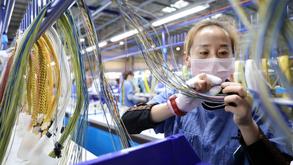 This undated photo captures an employee assembling a wire harness at the workshop of Draexlmaier (Anshan) Wire Harness System Co in Anshan, Liaoning province. (PHOTO / XINHUA)
This undated photo captures an employee assembling a wire harness at the workshop of Draexlmaier (Anshan) Wire Harness System Co in Anshan, Liaoning province. (PHOTO / XINHUA)
BEIJING - China managed to keep prices of staple goods and production materials stable in July despite a resurgence of COVID-19 cases and severe floods that disrupted economic activities, official data showed Monday.
The consumer price index (CPI), a main gauge of inflation, rose 1 percent year on year last month, lower than the 1.1 percent year-on-year growth recorded in June, data from the National Bureau of Statistics (NBS) showed.
The producer price index (PPI), which measures costs for goods at the factory gate, expanded 9 percent year on year in July, slightly higher than the 8.8-percent growth seen in June.
Extreme weather and a COVID-19 resurgence since July have posed challenges to agricultural production and economic operation in some regions. In central China's Henan Province, for example, unprecedented floods ravaged farmland and disrupted normal lives, while a fresh spike in COVID-19 cases caused mainly by the Delta variant added to the pain
"Market demand and supply remained basically steady last month amid government measures to coordinate COVID-19 control, disaster relief and economic growth," said senior NBS statistician Dong Lijuan.
Extreme weather and a COVID-19 resurgence since July have posed challenges to agricultural production and economic operation in some regions. In central China's Henan Province, for example, unprecedented floods ravaged farmland and disrupted normal lives, while a fresh spike in COVID-19 cases caused mainly by the Delta variant added to the pain.
ALSO READ: Inflation poised for recovery
Authorities have taken swift measures in response to the challenges. The country's top economic planner has called on all localities to strengthen market price monitoring and early warning, and release reserves when appropriate to ensure the supply of the staple goods and avoid sharp increases in prices.
In July, the country's food prices declined 3.7 percent year on year while non-food prices increased 2.1 percent, NBS data showed.
On a monthly basis, CPI increased 0.3 percent, reversing a decline seen in June. Affected by typhoons and heavy rains in some regions, costs for the production, storage and transportation of vegetables rose, contributing to their price increases, Dong noted.
China has set its consumer inflation target at approximately 3 percent for the year 2021, according to this year's government work report.
On the industrial side, sharp price hikes in crude oil and coal lifted year-on-year PPI growth in July, but month-on-month data showed that government policies to stabilize commodity prices have taken effect, with mild price declines seen in industries including steel and non-ferrous metals, Dong noted.
The prices of agricultural production materials rose rapidly in July compared with June, with a relatively fast increase in prices of fertilizers and pesticides, NBS data showed.
READ MORE: China's consumer inflation up 1.1% year-on-year in June
To ease the pressure of rising commodity prices on the costs of companies, the country has rolled out a string of measures, including releasing national metal reserves and offering liquidity to companies through a cut in banks' reserve requirement ratio.


